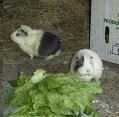 |
Bungala Ridge Permaculture Gardens REDUCE ... REUSE ... RECYCLE ... REPAIR ... RETURN ... REVEGETATE ... REPLENISH |
||||||||
|
|||||||||
|
|
Permaculture Techniques - Plant Stacking Description Plant stacking refers to the way in which plants are placed to achieve mutually beneficial relationships based on observation of natural plant systems and the way in which plants grow together. This is often referred to as plant 'guilds', and focuses on interactions rather than single elements. Guilds have several vertical levels, and involve successions over time, with pioneer and climax species occurring as the system evolves. Successions are dependent on site conditions and are affected by changes in them. Permaculture systems select plant species and place them to achieve multiple functions and yields organising plant guilds (thus supporting animal and other life). Benefits The following benefits are derived from plant stacking:
Procedure Consideration must be given to the following factors in species selection:
Begin with pioneer or nurse species in site rehabilitation. Don't disturb existing natural or productive guilds. Consider vertical as well as horizontal space when designing, and use vertical surfaces on existing or planned structures (including established shrubs and trees where possible) for plant community evolution.
|
Hot Links!
This site is sponsored by
|
|||||||
|
|
|
|
|||||||




